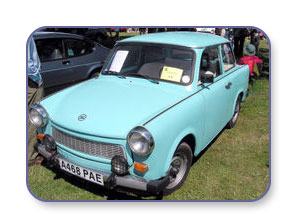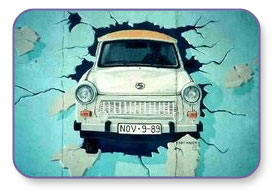| Stufe 3, Seite B
 Wiederholung: Das Imperfekt Wiederholung: Das Imperfekt
We have spent a lot of time reviewing the Perfekt. That is not because it is difficult, but rather because it's used so very much in everyday speaking - which is also why it has the nickname "conversational past." Just as in English, however, there is another tense used to talk about past events. The English tense is usually called "past"; the German version is called das Imperfekt. Textbooks may refer to it as the "narrative past," because it is used to express a series of connected past events, as if you were narrating a story. It is used much more in writing than in speaking. A few very common verbs (especially haben, sein, and the modals,) are used more in the Imperfekt than the Perfekt in everyday speech.
 Here is the pattern for weak verbs in the imperfect: Here is the pattern for weak verbs in the imperfect:
stem* + -te + past tense endings**
*Note that weak verbs keep the same stem in all tenses.
**Note also that the "past tense endings" are the same for all three groups of verbs: weak, strong, hybrids.
sagen: to say
|
| |
stem |
-te |
ending |
| ich |
sag |
te |
|
| du |
sag |
te |
st |
| er/sie/es |
sag |
te |
|
| wir |
sag |
te |
n |
| ihr |
sag |
te |
t |
| sie/Sie |
sag |
te |
n |
 Here is the pattern for strong verbs in the imperfect: Here is the pattern for strong verbs in the imperfect:
changed stem* + past tense endings
*The definition of a strong verb is one that changes its stem in the imperfect (narrative past) and does NOT have the -te that weak verbs have.
Gehen: to go
|
| |
stem |
ending |
| ich |
ging |
|
| du |
ging |
st |
| er/sie/es |
ging |
|
| wir |
ging |
en |
| ihr |
ging |
t |
| sie/Sie |
ging |
en |
Here is a list of some common imperfect tense stems for strong verbs. Remember that the correct endings need to be added to these stems to conjugate them correctly.
| nahm |
took |
| kam |
came |
| fuhr |
rode, traveled |
| las |
read |
| sang |
sang |
| lief |
ran, walked |
| schrieb |
wrote |
| war |
was |
| fand |
found |
 Here is the pattern for hybrid* verbs in the imperfect: Here is the pattern for hybrid* verbs in the imperfect:
changed stem* + -te + past tense endings
Remember: hybrids are mixtures of both strong and weak:
the changed stem from the strong and the -te from the weak
|
Here are some of the more common hybrids:
| Infinitive |
Changed Stem + -te |
Meaning |
| wissen |
wuss + te |
knew (facts) |
| kennen |
kann + te |
knew ( was acquainted with) |
| müssen |
muss + te |
had to |
| können |
konn + te |
was able to, could |
| dürfen |
durf + te |
was allowed / permitted to |
| nennen |
nann + te |
named |
| mögen |
moch + te |
liked |
| rennen |
rann + te |
ran |
 Üben wir
Üben wir das Imperfekt mit diesem Kreuzworträtsel. Üben wir
Üben wir das Imperfekt mit diesem Kreuzworträtsel.
das Imperfekt
Directions: Give the er,sie,es form in Imperfekt
 Vokabelntipp Vokabelntipp
In German 1 and 2, we learned about several suffixes.
Two of them (-chen and -lein) are added to nouns to indicate a "diminutive" (i.e. a smaller version). Words ending in either of these suffixes are ALWAYS neuter, and their plural is ALWAYS the same as the singular. (Most of them have an umlaut added to the vowel as well.)
die Frau, -en + -lein = das Fräulein, -
Hans (John, name) + -chen = Hänschen (Johnny)
das Buch, -``er + -lein = das Büchlein
die Maus, -``e + -chen = das Mäuschen
Other suffixes that we looked at have no special meaning but are often equivalent to specific English suffixes. Here are some of them:
| German suffix |
English suffix |
German examples |
English equivalents |
-schaft
(always feminine, pl. = -en) |
-ship |
die Freundschaft, -en
die Meisterschaft, -en |
friendship
championship |
| -iv |
-ive |
aktiv
massiv |
active
massive |
| -lich |
-ly |
freundlich
körperlich |
friendly
bodily |
| -isch |
-ic. -ical |
logisch
typisch
hysterisch |
logical
typical
hysterical |
| -ismus |
-ism |
Patriotismus
Kubismus |
patriotism
cubism |
| -tät |
-ty |
Universität
Priorität |
university
priority |
| -ie |
-y |
Biologie
Galerie |
biology
gallery |
 Sachsenring Sachsenring
600cc 1983 Trabant P601L.
 We started the unit looking at some of the well-known cars that give Germany its reputation for engineering excellence. Now let's look at a car that has become almost a cult item throughout the world: the Trabant (Trabi). About 3 million of these East German cars were produced by the Sachsenring company between , with very little change over the years. We started the unit looking at some of the well-known cars that give Germany its reputation for engineering excellence. Now let's look at a car that has become almost a cult item throughout the world: the Trabant (Trabi). About 3 million of these East German cars were produced by the Sachsenring company between , with very little change over the years.
 East Germany did not have the resources the West had. Steel, especially, was not available for "luxury" items like automobiles, so a new material called Duraplast was developed. It was a composite of resin and cotton fibers, and it didn't rust! Because of its shape and its smoky two-stroke engine, Westerners often called it a box with a lawn-mower engine. East Germans, however, waited years for delivery of their prize, which could carry four adults and luggage and was uncomplicated enough to be repaired by the owner. East Germany did not have the resources the West had. Steel, especially, was not available for "luxury" items like automobiles, so a new material called Duraplast was developed. It was a composite of resin and cotton fibers, and it didn't rust! Because of its shape and its smoky two-stroke engine, Westerners often called it a box with a lawn-mower engine. East Germans, however, waited years for delivery of their prize, which could carry four adults and luggage and was uncomplicated enough to be repaired by the owner.
 When the Berlin Wall fell in 1989, there was a solid stream of Trabis rolling into West Germany, and the car became a symbol for this historic event. It has even had major roles in movies. Today, collectors all over the world prize their Trabis and have decorated them in very creative ways! When the Berlin Wall fell in 1989, there was a solid stream of Trabis rolling into West Germany, and the car became a symbol for this historic event. It has even had major roles in movies. Today, collectors all over the world prize their Trabis and have decorated them in very creative ways!
You are encouraged to research this site for more information and some fascinating stories:
http://home.clara.net/peterfrost/trabant.html
 Wiederholungsübung! Wiederholungsübung!
Was passt zusammen in diesem JigWord? (What matches up in this JigWord activity?)
 Schriftliche Aufgabe Schriftliche Aufgabe
Benutze Vokabeln von der ersten Vokabelliste und dem Lesestück und schreib 5 Sätze auf Deutsch im Perfekt. Das Thema ist "ein Tag auf der Reise." Wenn du die Sätze tippst, unterstreiche alle Verben. (Using vocabulary from the first list and from the reading, write 5 sentences about "one day on a vacation." When you type up your sentences, underline all the verbs.) Diese Aufgabe hat 15 Punkte.
Weiter: Stufe 3, Seite C
|